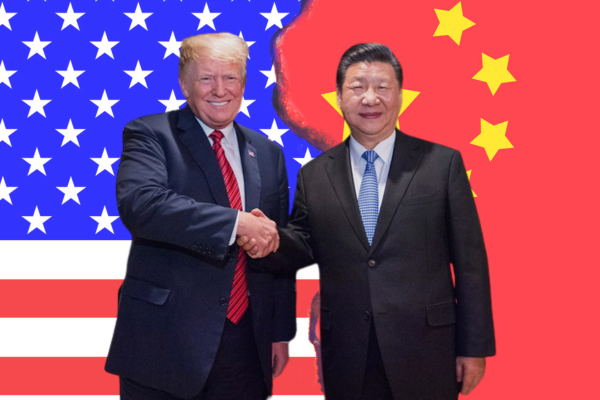.png)

Ajay Srivastava, founder of Global Trade Research Initiative, is an ex-Indian Trade Service officer with expertise in WTO and FTA negotiations.
November 2, 2025 at 3:42 PM IST
India’s exports to its largest market, the United States, are reeling under the weight of steep US tariff hikes. Between May and September 2025, exports plunged by 37.5%—from $8.8 billion to $5.5 billion—marking one of the sharpest short-term collapses in years.
The Global Trade Research Initiative’s analysis compares export performance between May and September 2025 to assess the immediate fallout of US tariffs imposed from April 2 onward.
These duties began at 10%, rose to 25% on August 7, and reached 50% by late August.
To gauge the full extent of the impact, India’s exports to the US were grouped into three categories: tariff-free products, uniformly taxed goods, and those slapped with a punitive 50% duty specific to India.
Category A: Tariff-Free Exports Take the Hardest Hit
Paradoxically, tariff-free products—accounting for nearly one-third of India’s total shipments—saw the steepest contraction, falling 47% from $3.4 billion in May to $1.8 billion in September. Smartphones and pharmaceuticals were the biggest casualties.
Smartphone exports, which had surged 197% between April–September 2024 and the same period in 2025, crashed 58% from $2.29 billion in May to $884.6 million in September. Shipments fell month after month—$2.0 billion in June, $1.52 billion in July, $964.8 million in August, and finally $884.6 million in September. The reasons for decline are not known and need examination.
Pharmaceutical product exports slipped 15.7%, from $745.6 million to $628.3 million.
Despite tariff exemption, these two flagship sectors—both beneficiaries of India’s PLI manufacturing program—show a disproportionate fall.
Category B: Uniform-Tariff Sectors Show Milder Weakness
Industrial metals and auto parts—subject to uniform tariffs for all countries—registered a milder 16.7% decline, from $0.6 billion to $0.5 billion. Aluminum exports dropped 37%, copper 25%, auto parts 12%, and iron and steel 8%. Because all global suppliers faced similar duties, the dip appears linked more to a slowdown in US industrial activity than to any loss in Indian competitiveness.
Category C: 50% India-Specific Tariffs Cripple Labour-Intensive Sectors
The labour-intensive sectors such as textiles, gems and jewellery, chemicals, agri-foods, and machinery account for nearly 60% of India’s US exports and suffered a 33% decline—from $4.8 billion in May to $3.2 billion in September.
Gems and Jewellery
Exports collapsed 59.5%, from $500.2 million to $202.8 million, battering units in Surat and Mumbai as Thailand and Vietnam captured lost US orders. Gold jewellery fell 58%, diamond-studded pieces 63%, and lab-grown jewellery 37%. Cut and polished diamonds dropped 54%, while lab-grown diamond exports plunged 89%.
Solar Panels
Exports of solar panels plunged 60.8%, from $202.6 million to $79.4 million, eroding India’s renewable-energy export edge. With China facing only 30% tariffs and Vietnam 20%, India’s competitiveness has sharply deteriorated.
Textiles and Garments
Exports of textiles, garments, and made-ups fell 37%, from $944 million to $597 million. Garments alone declined 44%, home textiles 16%, and yarn and fabrics 41%. Within garments, knitted apparel was down 39%, woven apparel 50%, and girls’ suits 66%.
Chemicals
Chemical exports shrank 35%—from $537 million to $350 million—driven by a 37% fall in agrochemicals and 44% in essential oils. The downturn has hurt producers in Vapi, Dahej, Ankleshwar, and Vizag, home to large firms such as UPL and Rallis India, as well as numerous MSMEs in Maharashtra and Karnataka.
Marine and Seafood
Exports of marine and seafood products declined 49%—from $223 million to $113 million—dealing a blow to one of India’s most labour-intensive sectors. Vannamei shrimp exports were down 51%, and processed seafood 22%. Coastal hubs such as Nellore, Bhimavaram, Kakinada, Paradeep, Veraval, and Porbandar have been hit hard as buyers shift to Ecuador and Vietnam.
Agriculture and Processed Foods
Agricultural exports recorded a broad-based slump. Preparations of cereals fell 27%, processed fruits and vegetables 44%, roots and tubers 45%, cocoa products 99%, oilseeds 53%, dairy and honey 59%, processed foods 35%, coffee and spices 40%, and resins 61%.
The losses have severely affected clusters in Nashik, Gujarat, Kerala, Karnataka, Jharkhand, and Chhattisgarh, wiping out two years of steady gains.
Policy Response
Exporters are urging the government to respond swiftly. Priority measures include enhanced interest-equalisation support to lower financing costs, faster duty remission to ease liquidity pressure, and emergency credit lines for MSME exporters.
Without urgent intervention, India risks losing market share to Vietnam, Mexico, and China—even in sectors where it previously held a strong position. The latest data make one point clear: tariffs have not only squeezed India’s trade margins but also exposed structural vulnerabilities across key export industries.
Data Source- DGCI&S, USITC DataWeb (U.S. Trade & Tariff Data) and private websites




